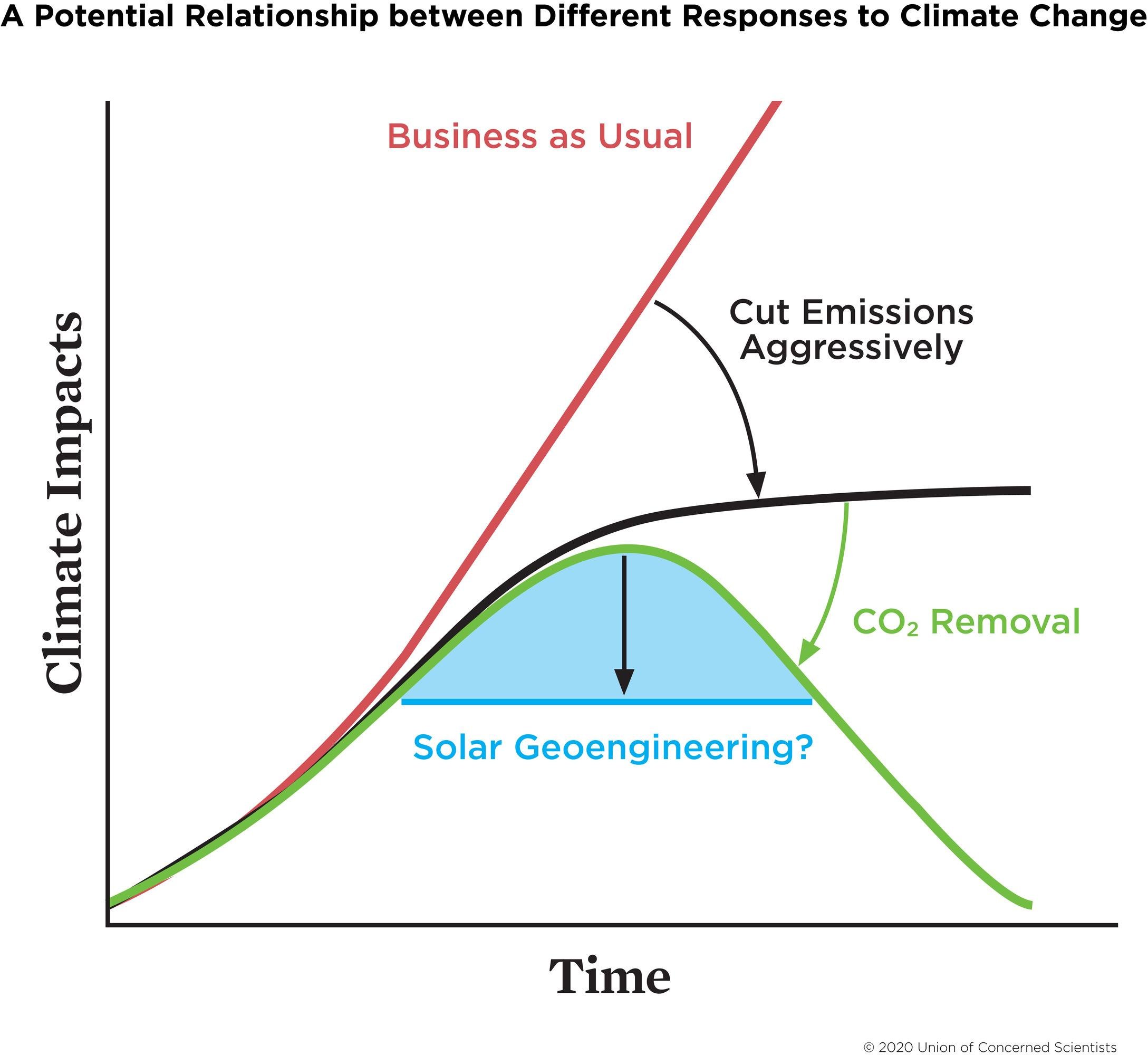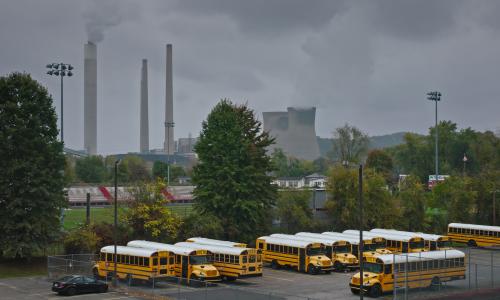Table of Contents
Solar geoengineering technologies cool the earth by reflecting sunlight back into space—but they pose many risks, challenges, and uncertainties.
Scientists agree that we need to swiftly and dramatically cut emissions of heat-trapping gases. Also necessary: safely and sustainably removing carbon dioxide from the atmosphere, and accelerating investments to prepare for the impacts of climate change.
These measures are essential. But because they may not be enough to avoid substantial climate disruption, some researchers are also looking to better understand the risks and benefits of solar geoengineering.
Solar geoengineering refers to proposed approaches to cool the Earth by reflecting solar radiation back to space. The two main approaches being researched are stratospheric aerosol injection (SAI) and marine cloud brightening (MCB).
The Union of Concerned Scientists opposes the deployment of solar geoengineering because it poses unacceptably high environmental, social, and geopolitical risks. Instead, UCS supports continued modeling research, observational studies, and strong, inclusive public participation in decision-making over whether and how further research should include possible small-scale outdoor experiments.
The Union of Concerned Scientists opposes the deployment of solar geoengineering because it poses unacceptably high environmental, social, and geopolitical risks.
What is solar geoengineering?
Solar geoengineering—also referred to as solar radiation management—describes a set of proposed approaches to reflect sunlight to rapidly cool the Earth.
Within solar geoengineering, researchers are considering two main approaches. The first—stratospheric aerosol injection, or SAI—would involve injecting tiny reflecting particles, known as aerosols, into the upper atmosphere to cool the planet. The second—marine cloud brightening, or MCB—would use sea salt to stimulate cloud formation over the ocean, which would also help reflect sunlight in the region.
In effect, SAI simulates what happens during large volcanic eruptions, when volcanoes emit small particles into the upper atmosphere (called the stratosphere). These particles reflect sunlight and lead to cooling for as long as they remain in the stratosphere, which may be up to a few years after injection. By injecting sulfate or other aerosol particles into the stratosphere, SAI would mimic the cooling effect of a large volcanic eruption’s effect of lower global temperatures.
If ever deployed, SAI would have global impacts, reducing temperatures and altering precipitation patterns across the planet.
MCB would involve spraying sea salt into low-lying marine clouds to enhance their brightness and reflectivity in order to increase regional-scale cooling. Researchers have been examining the risks and benefits of solar geoengineering through computer modeling and observational studies for several years.
This research has been valuable in gaining a deeper understanding of the possible consequences of solar geoengineering. But many questions remain unanswered, including whether and how solar geoengineering might ever be responsibly governed.
Why is solar geoengineering being considered?
Solar geoengineering would not address the root cause of climate change: emissions of heat-trapping gases, mostly from the burning of fossil fuels. It would not limit ocean acidification or the many harmful impacts on public health and the environment from fossil fuel use.
So why research it?
Because even as we take critical steps to slow climate change, they may not be enough to limit warming to the levels needed to avoid catastrophic consequences. Limiting global temperature increase to the Paris Agreement’s target of “well below 2°C above preindustrial levels and pursuing efforts to limit the temperature increase to 1.5°C” requires that the United States and other nations bring net global carbon dioxide (CO2) emissions to zero by no later than mid-century, alongside deep cuts in emissions of other heat-trapping gases.
These are ambitious goals that we must make every effort to achieve. But we must also prepare for the possibility that global efforts may fall short. And we must recognize that even at 1.5°C, the world faces severe climate risks. Further warming threatens public health, food security, housing and water availability, and national security—just to name a few areas of impact.
Even as researchers assess the potential feasibility and effectiveness of geoengineering approaches, mitigation and adaptation must remain our first-line solutions.
To date, research to scope the risks and potential of solar geoengineering has mostly been conducted through computer-based modelling and natural observations.
Proposals and plans to expand research in solar geoengineering now include initiatives to conduct small-scale atmospheric experiments in the US and in Australia’s Great Barrier Reef. Even small-scale experiments with limited environmental and societal risk deserve significant public scrutiny and debate as they accelerate attention and legitimate concern about the potential for larger-scale, potentially riskier experiments, and possible deployment.
Because solar geoengineering has global implications, its consideration as a climate response requires effective international governance. Sound governance would need to be sustained for a very long time. Even uses intended to be “temporary,” such as deploying stratospheric aerosols to limit peak warming while we aggressively reduce emissions, would likely need to be sustained for a half-century or more.
Solar geoengineering risks and the need for governance
Given the uncertainties and risks, solar geoengineering is deeply problematic.
One such risk is “moral hazard”—the danger that the technology will become an excuse to slow emissions reductions and stop moving toward a low-carbon economy.
Solar geoengineering could limit some harmful climate impacts. But aside from potential adverse impacts, it would not address the root cause of climate change: rising emissions of heat-trapping gases from burning fossil fuels—or some of the resulting impacts, such as ocean acidification.
Most importantly, we know a little about how it could impact regional weather patterns, through prior volcanic eruptions. But this is insufficient for understanding sustained solar geoengineering.
We know very little about how solar geoengineering could impact global politics and efforts to curb global warming emissions. And because injecting aerosols into the stratosphere has regional and global implications, outdoor experimentation is a difficult subject to address. Its transboundary nature makes the line between small- and large-scale research a murky but critical one, necessitating different approaches and responses.
Given the ethical and environmental risks these activities can present, atmospheric experiments to assess these technologies deserve timely public scrutiny and debate. That’s why, before solar geoengineering is tested outdoors, it’s important that scientists and civil society insist that governments put in place:
- Mechanisms for oversight,
- rules for transparency in conducting research,
- and ways to involve the public in decision-making over whether and under what conditions outdoor experiments would be allowed to take place.
In those discussions, there should be substantial leadership from the nations and communities most vulnerable to climate change. Their voices must drive decision making and help shape research priorities. Diverse views prompt questions and ideas that discussions largely confined to select spaces in the global north cannot presume to know.
In addition, researchers should accept funding only from entities and governments that unequivocally support mitigation and adaptation measures to address the root of the climate crisis.
UCS’s position on solar geoengineering
UCS strongly opposes any deployment of solar geoengineering. The reasoning: the technologies currently pose significant environmental, ethical, and geopolitical risks, challenges, and uncertainties.
Society must exercise great care as it considers escalating solar geoengineering research and its possible future deployment. And it must do so with substantial leadership from nations and communities most vulnerable to climate change.
To better understand the potential and risks of solar geoengineering, researchers should use computer modeling and monitor the climatic impacts of events such as volcanic eruptions.
At the same time, UCS strongly opposes stratospheric tests of solar geoengineering technologies at a scale that could have a measurable impact on Earth’s surface climate.
UCS believes that any small-scale atmospheric experiments should meet the following criteria:
- Legitimate independent governance mechanisms are established to ensure that proposed experiments have high scientific quality and value and pose no environmental, social, and legal risks.
- Governance mechanisms must be transparent and inclusive, ensuring meaningful engagement with climate-vulnerable communities and the public, and provide oversight over the duration of the experiments.
- Independent governance of proposed outdoor experiments.
- Funding for solar geoengineering experiments comes only from governments and other entities that support mitigation and adaptation as the first-line solutions to climate change, and
- codevelop solar geoengineering research priorities in collaboration with researchers and stakeholders in climate-vulnerable nations and communities.
There remains much to be understood about solar geoengineering. UCS recommends a precautionary approach to examining all potential climate response options. This includes developing a careful understanding of risks and potential benefits of solar geoengineering technologies to rapidly cool the Earth by reflecting sunlight back into space.








